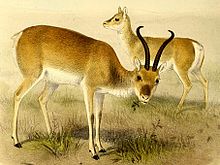
Procapra przewalskii

Przewalski's gazelle (Procapra przewalskii) is a member of the family Bovidae, and in the wild, is found only in China. Once widespread, its range has declined to six populations near Qinghai Lake. The gazelle was named after Nikolai Przhevalsky, a Russian explorer who collected a specimen and brought it back to St. Petersburg in 1875. Przewalski's gazelles are relatively small, slender antelopes with large eyes and short, pointed ears. The nasal bones are relatively large, suggesting an adaptation to the thin air of the Tibetan plateau. They have a head and body length of 109 to 160 cm (43 to 63 in), a shoulder height of 50 to 70 cm (20 to 28 in), and weigh between 17 and 32 kg (37 and 71 lb). Males are generally larger and heavier than the females. The tail is short, measuring only 7 to 10 cm (2.8 to 3.9 in), and is often entirely hidden by fur. The animal is yellowish brown with a white underside and a white heart-shaped patch on its rump, partially bisected by a light brown vertical line. Males are darker in colour than females, and the coat of both sexes is more noticeably greyish in winter. The fur lacks an undercoat, consisting only of dense guard hairs. Male Przewalski's gazelles have ridged horns, which rise between the eyes and curve inwards at the tips; in younger males, the tips may actually touch, but they diverge as the animal ages. In the adult, the horns reach 18 to 26 cm (7.1 to 10.2 in) in length. The females are hornless. Przewalski's gazelle is similar in appearance to both the Tibetan gazelle and the Mongolian gazelle, to both of which it is closely related, and occurs in similar geographic areas. It is intermediate in size between the other two species, and can most easily be distinguished from them by the shape of its horns. Until the early 20th century, Przewalski's gazelle was widespread across the high plateaus of northwestern China and Inner Mongolia. However, it is now found only in a single small area around Qinghai Lake, having been extirpated across the great majority of its former range. It inhabits flat open valleys and steppeland between mountains, and the sand dunes and semi-desert zones around lakes. Two sub-species have been described, although one is now believed to be extinct: The preferred diet of Pzewalski's gazelles consists of sedges and grasses, supplemented by herbs and shrubs such as Astragalus. They are often found foraging together with Tibetan gazelles, but do not compete for resources because the latter animal prefers legumes. Such associations with a related species allow for larger herds, which may help protect both species from predators. The gazelle usually travels in small groups, with rarely more than a dozen individuals, although much larger herds were reported in the 19th century, when the overall population was higher. Males are often solitary or travel in small groups of two or three individuals for much of the year, but gather together in small herds with the females during the winter rut.
